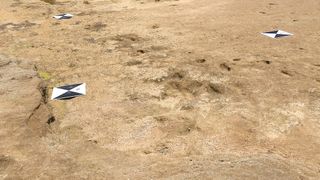
Researchers discovered 85 footprints made by humans thousands of years ago at a beach in Morocco.
(Image credit: M. Sedrati, et al)
Two trails of ancient human footprints pressed into a beach in Morocco form one of the largest and best-preserved trackways in the world.
Researchers happened upon the footprint site near the northern tip of North Africa in 2022 while studying boulders at a nearby pocket beach, according to a study published Jan. 23 in the journal Scientific Reports.
“Between tides, I said to my team that we should go north to explore another beach,” study lead author Mouncef Sedrati, an associate professor of coastal dynamics and geomorphology at the University of Southern Brittany in France, told Live Science. “We were surprised to find the first print. At first, we weren’t convinced it was a footprint, but then we found more of the trackway.”
Related: 153,000-year-old footprints from South Africa are the oldest Homo sapiens tracks on record
Analysis of the site, which is the only known human trackway site of its kind in North Africa and the Southern Mediterranean, revealed two trails containing a total of 85 human footprints stamped into the beach by a group of at least five early modern humans.
The team used optically stimulated luminescence dating, a technique that determines when specific minerals on or near an artifact were last exposed to heat or sunlight. Based on the age of the fine grains of quartz that make up the bulk of the gently sloped beach’s sand, researchers determined that a multigenerational group of Homo sapiens walked on the beach roughly 90,000 years ago, creating the pathways. The event took place during the Late Pleistocene, also known as the last ice age, which ended around 11,700 years ago, according to the study.
“We took measurements on-site to determine the length and depth of the prints,” Sedrati said. “Based on the foot pressure and size of the footprints, we were able to determine the approximate age of the individuals, which included children, adolescents and adults.”
The researchers credit the excellent preservation of the ancient impressions to a number of factors, including the beach’s layout and the long reach of the tides for “the final preservation of the footprints,” according to the study.
“The exceptional thing is the position of the beach on a rocky platform that is covered in clay sediments,” Sedrati said. “These sediments create good conditions to preserve the tracks on the sandbar while the tides rapidly buried the beach. That’s why the footprints are so well preserved here.”
However, the researchers remain uncertain about what the ice age group was doing on the beach, and future analysis of the site could reveal that information. But they’ll have to act quickly, as “the ongoing collapse of the rocky shore platform … could lead to its eventual demise,” including of the tracks preserved on it, the team wrote in the study.
“We hope to learn about the total history of this group of humans and what they were doing there,” Sedrati said.
Get the world’s most fascinating discoveries delivered straight to your inbox.
Jennifer Nalewicki is a Salt Lake City-based journalist whose work has been featured in The New York Times, Smithsonian Magazine, Scientific American, Popular Mechanics and more. She covers several science topics from planet Earth to paleontology and archaeology to health and culture. Prior to freelancing, Jennifer held an Editor role at Time Inc. Jennifer has a bachelor’s degree in Journalism from The University of Texas at Austin.
>>> Read full article>>>
Copyright for syndicated content belongs to the linked Source : Live Science – https://www.livescience.com/archaeology/90000-year-old-human-footprints-found-on-a-moroccan-beach-are-some-of-the-oldest-and-best-preserved-in-the-world































